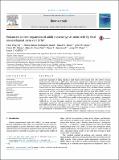| dc.contributor.author | Ng, Chee Ping | |
| dc.contributor.author | Mohamed Sharif, Abdul Rahim | |
| dc.contributor.author | Heath, Daniel E. | |
| dc.contributor.author | Chow, John W. | |
| dc.contributor.author | Zhang, Claire BY. | |
| dc.contributor.author | Chan-Park, Mary B. | |
| dc.contributor.author | Hammond, Paula T. | |
| dc.contributor.author | Chan, Jerry K. Y. | |
| dc.contributor.author | Griffith, Linda G. | |
| dc.date.accessioned | 2014-08-21T18:30:04Z | |
| dc.date.available | 2014-08-21T18:30:04Z | |
| dc.date.issued | 2014-02 | |
| dc.date.submitted | 2013-11 | |
| dc.identifier.issn | 01429612 | |
| dc.identifier.issn | 1878-5905 | |
| dc.identifier.uri | http://hdl.handle.net/1721.1/88963 | |
| dc.description.abstract | Large-scale expansion of highly functional adult human mesenchymal stem cells (aMSCs) remains technologically challenging as aMSCs lose self renewal capacity and multipotency during traditional long-term culture and their quality/quantity declines with donor age and disease. Identification of culture conditions enabling prolonged expansion and rejuvenation would have dramatic impact in regenerative medicine. aMSC-derived decellularized extracellular matrix (ECM) has been shown to provide such microenvironment which promotes MSC self renewal and “stemness”. Since previous studies have demonstrated superior proliferation and osteogenic potential of human fetal MSCs (fMSCs), we hypothesize that their ECM may promote expansion of clinically relevant aMSCs. We demonstrated that aMSCs were more proliferative (∼1.6×) on fMSC-derived ECM than aMSC-derived ECMs and traditional tissue culture wares (TCPS). These aMSCs were smaller and more uniform in size (median ± interquartile range: 15.5 ± 4.1 μm versus 17.2 ± 5.0 μm and 15.5 ± 4.1 μm for aMSC ECM and TCPS respectively), exhibited the necessary biomarker signatures, and stained positive for osteogenic, adipogenic and chondrogenic expressions; indications that they maintained multipotency during culture. Furthermore, fMSC ECM improved the proliferation (∼2.2×), size (19.6 ± 11.9 μm vs 30.2 ± 14.5 μm) and differentiation potential in late-passaged aMSCs compared to TCPS. In conclusion, we have established fMSC ECM as a promising cell culture platform for ex vivo expansion of aMSCs. | en_US |
| dc.description.sponsorship | Singapore-MIT Alliance for Research and Technology | en_US |
| dc.language.iso | en_US | |
| dc.publisher | Elsevier | en_US |
| dc.relation.isversionof | http://dx.doi.org/10.1016/j.biomaterials.2014.01.081 | en_US |
| dc.rights | Creative Commons Attribution-NonCommercial-No Derivative Works 3.0 | en_US |
| dc.rights.uri | http://creativecommons.org/licenses/by-nc-nd/3.0/ | en_US |
| dc.source | Elsevier Open Access | en_US |
| dc.title | Enhanced ex vivo expansion of adult mesenchymal stem cells by fetal mesenchymal stem cell ECM | en_US |
| dc.type | Article | en_US |
| dc.identifier.citation | Ng, Chee Ping, Abdul Rahim Mohamed Sharif, Daniel E. Heath, John W. Chow, Claire BY. Zhang, Mary B. Chan-Park, Paula T. Hammond, Jerry KY. Chan, and Linda G. Griffith. “Enhanced Ex Vivo Expansion of Adult Mesenchymal Stem Cells by Fetal Mesenchymal Stem Cell ECM.” Biomaterials 35, no. 13 (April 2014): 4046–4057. | en_US |
| dc.contributor.department | Massachusetts Institute of Technology. Department of Biological Engineering | en_US |
| dc.contributor.department | Massachusetts Institute of Technology. Department of Chemical Engineering | en_US |
| dc.contributor.department | Massachusetts Institute of Technology. Department of Mechanical Engineering | en_US |
| dc.contributor.mitauthor | Hammond, Paula T. | en_US |
| dc.contributor.mitauthor | Griffith, Linda G. | en_US |
| dc.relation.journal | Biomaterials | en_US |
| dc.eprint.version | Final published version | en_US |
| dc.type.uri | http://purl.org/eprint/type/JournalArticle | en_US |
| eprint.status | http://purl.org/eprint/status/PeerReviewed | en_US |
| dspace.orderedauthors | Ng, Chee Ping; Mohamed Sharif, Abdul Rahim; Heath, Daniel E.; Chow, John W.; Zhang, Claire BY.; Chan-Park, Mary B.; Hammond, Paula T.; Chan, Jerry KY.; Griffith, Linda G. | en_US |
| dc.identifier.orcid | https://orcid.org/0000-0002-1801-5548 | |
| mit.license | PUBLISHER_CC | en_US |
| mit.metadata.status | Complete | |
